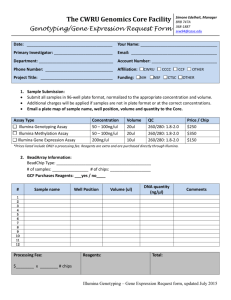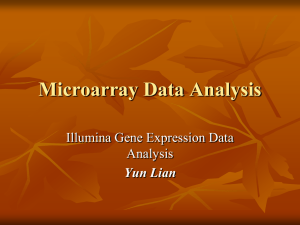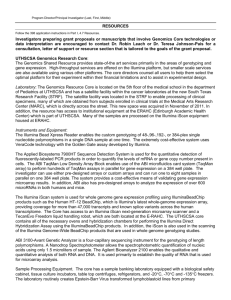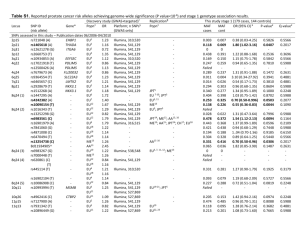Wilmes et al. 2013 - Springer Static Content Server
advertisement
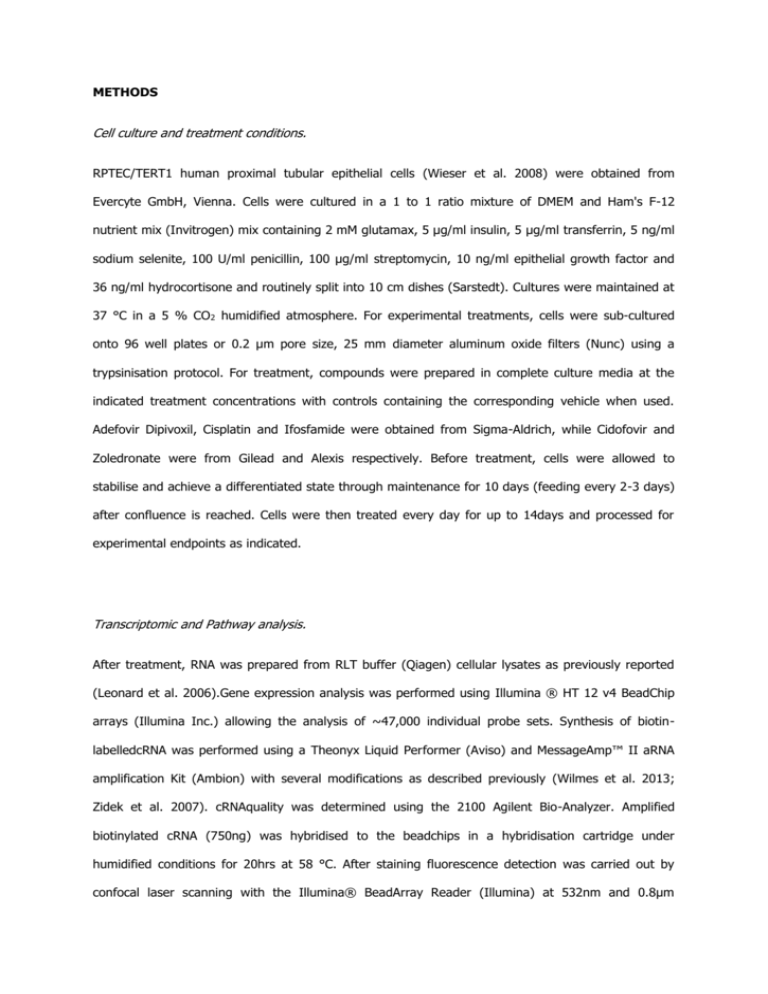
METHODS Cell culture and treatment conditions. RPTEC/TERT1 human proximal tubular epithelial cells (Wieser et al. 2008) were obtained from Evercyte GmbH, Vienna. Cells were cultured in a 1 to 1 ratio mixture of DMEM and Ham's F-12 nutrient mix (Invitrogen) mix containing 2 mM glutamax, 5 μg/ml insulin, 5 μg/ml transferrin, 5 ng/ml sodium selenite, 100 U/ml penicillin, 100 μg/ml streptomycin, 10 ng/ml epithelial growth factor and 36 ng/ml hydrocortisone and routinely split into 10 cm dishes (Sarstedt). Cultures were maintained at 37 °C in a 5 % CO2 humidified atmosphere. For experimental treatments, cells were sub-cultured onto 96 well plates or 0.2 μm pore size, 25 mm diameter aluminum oxide filters (Nunc) using a trypsinisation protocol. For treatment, compounds were prepared in complete culture media at the indicated treatment concentrations with controls containing the corresponding vehicle when used. Adefovir Dipivoxil, Cisplatin and Ifosfamide were obtained from Sigma-Aldrich, while Cidofovir and Zoledronate were from Gilead and Alexis respectively. Before treatment, cells were allowed to stabilise and achieve a differentiated state through maintenance for 10 days (feeding every 2-3 days) after confluence is reached. Cells were then treated every day for up to 14days and processed for experimental endpoints as indicated. Transcriptomic and Pathway analysis. After treatment, RNA was prepared from RLT buffer (Qiagen) cellular lysates as previously reported (Leonard et al. 2006).Gene expression analysis was performed using Illumina ® HT 12 v4 BeadChip arrays (Illumina Inc.) allowing the analysis of ~47,000 individual probe sets. Synthesis of biotinlabelledcRNA was performed using a Theonyx Liquid Performer (Aviso) and MessageAmp™ II aRNA amplification Kit (Ambion) with several modifications as described previously (Wilmes et al. 2013; Zidek et al. 2007). cRNAquality was determined using the 2100 Agilent Bio-Analyzer. Amplified biotinylated cRNA (750ng) was hybridised to the beadchips in a hybridisation cartridge under humidified conditions for 20hrs at 58 °C. After staining fluorescence detection was carried out by confocal laser scanning with the Illumina® BeadArray Reader (Illumina) at 532nm and 0.8µm resolution. Illumina® BeadStudio software was used for condensing raw data and to further ensure array quality based on different control bead parameters as described for a previous study (Boehme et al. 2009).Quantile normalisation was also applied to account for non-biological variancebetween arrays. Collection and warehousing of array data was performedusing BASE (Emergentec Biodevelopment GmbH). Identification of differentially regulated probes was carried out using the Rpackage “limma” incorporating a moderated one-way ANOVA with a Benjamini–Hochbergcorrected pvalue below or equal to 0.05 as previously reported (Wilmes et al. 2013). Pathway and regulatory factor enrichment was performed using ingenuity pathway analysis (IPA) (IngenuitySystems) as previously described (Crean et al. 2013). This software uses an input of differentially regulated genes that have associated directional fold change and statistical p values as described above. It then compares this input against an in house database (Ingenuity Knowledge Base) of gene interactions and functional associations created from millions of individually modelled biological relationships identified from publically available sources such as Pubmed. The software calculates statistical associations between the input gene list and previously defined lists of genes categorised into functional groupings such as “canonical pathways” and “upstream regulators”. Protein Quantification by ELISA Changes in protein levels of IL-19, LCN2 and SerpinA3 in cell culture media and Interleukin-19 and Lipocalin-2 in urine were determined by enzyme-linked immunosorbent assay (ELISA). IL-19 and LCN2 were assayed using Duoset kits from RND systems and SerpinA3 using an ELISA kit from Genway BioSciences according to manufacturers’ instructions and as previously described (O'Reilly et al. 2006). Patient population and clinical analysis Matched serum and urine were collected from 9 healthy volunteers and 77 chronic kidney disease (CKD) patients with diagnosed conditions including ANCA-associated vasculitis, lupus nephritis, minimal change nephropathy, membranous nephropathy and IgA nephropathy and familial juvenile hyperuricaemic nephropathy as previously reported (Prajczer et al. 2010). Urine and serum samples were stored below−20°C until assay. Only excess samples from routine clinical investigations were used and such use for research purposes was approved by the local institutional ethics board. Urinary and serum creatinine was measured by the Jaffe reaction. Urinary protein was measured by the turbidimetricbenzalkonium chloride assay (Roche, Modular Analyser). Estimated glomerular filtration rate (eGFR) was calculated using the Modification of Diet in Renal Disease (MDRD) formula (Levey et al. 1999). Urinary N-acetyl-β-D-glucosaminidase (NAG) was measured by a colorimetric assay (PPR Diagnostics). Boehme K, Simon S, Mueller SO (2009) Gene expression profiling in Ishikawa cells: a fingerprint for estrogen active compounds. Toxicol Appl Pharmacol 236(1):85-96 doi:S0041-008X(09)000313 [pii] 10.1016/j.taap.2009.01.006 Crean D, Felice L, Pierre P, Jennings P, Leonard MO (2013) Inhibition of protein translation as a mechanism of acidotic pH protection against ischaemic injury through inhibition of CREB mediated tRNA synthetase expression. Experimental cell research doi:10.1016/j.yexcr.2013.07.017 Leonard MO, Kieran NE, Howell K, et al. (2006) Reoxygenation-specific activation of the antioxidant transcription factor Nrf2 mediates cytoprotective gene expression in ischemia-reperfusion injury. FASEB journal : official publication of the Federation of American Societies for Experimental Biology 20(14):2624-6 doi:10.1096/fj.06-5097fje Levey AS, Bosch JP, Lewis JB, Greene T, Rogers N, Roth D (1999) A more accurate method to estimate glomerular filtration rate from serum creatinine: a new prediction equation. Modification of Diet in Renal Disease Study Group. Annals of internal medicine 130(6):461-70 O'Reilly SM, Leonard MO, Kieran N, et al. (2006) Hypoxia induces epithelial amphiregulin gene expression in a CREB-dependent manner. American journal of physiology Cell physiology 290(2):C592-600 doi:10.1152/ajpcell.00278.2005 Prajczer S, Heidenreich U, Pfaller W, Kotanko P, Lhotta K, Jennings P (2010) Evidence for a role of uromodulin in chronic kidney disease progression. Nephrology, dialysis, transplantation : official publication of the European Dialysis and Transplant Association - European Renal Association 25(6):1896-903 doi:10.1093/ndt/gfp748 Wieser M, Stadler G, Jennings P, et al. (2008) hTERT alone immortalizes epithelial cells of renal proximal tubules without changing their functional characteristics. American journal of physiology Renal physiology 295(5):F1365-75 doi:10.1152/ajprenal.90405.2008 Wilmes A, Limonciel A, Aschauer L, et al. (2013) Application of integrated transcriptomic, proteomic and metabolomic profiling for the delineation of mechanisms of drug induced cell stress. Journal of proteomics 79:180-94 doi:10.1016/j.jprot.2012.11.022 Zidek N, Hellmann J, Kramer PJ, Hewitt PG (2007) Acute hepatotoxicity: a predictive model based on focused illumina microarrays. Toxicol Sci 99(1):289-302
